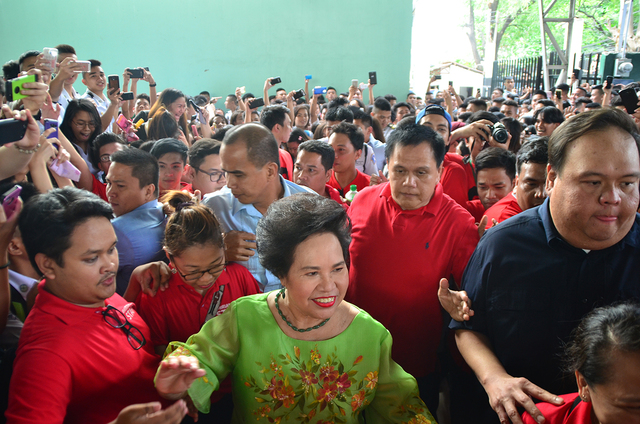Patty Pasion
(UPDATED) Presidential candidate Miriam Defensor Santiago dominates university polls, but she is at the tail end of the race when you survey a broader youth electorate
SOCIAL MEDIA ROCKSTAR. Senator Miriam Defensor Santiago is popular among the youth because of her use witty pick up lines and jokes in her speeches. Photo from Miriam Santiago's Media Bureau
MANILA, Philippines (UPDATED) – For the youth, at least according to university polls, Senator Miriam Defensor Santiago will finally secure the presidency in 2016, on her 3rd try.
The presidential candidate dominates surveys conducted in different schools. The former law professor recently topped the University of the Philippines (UP) survey, with 56.6% of 11,700 respondents from 3 UP units – Diliman, Los Baños and Manila – preferring her over other candidates.
There is no dull moment when she visits universities. Students would squeeze themselves in the crowd to take a selfie with the senior lawmaker. Her speeches about academic excellence and public accountability are always lauded. Of all the presidential candidates, only Santiago has the visible youth army campaigning for her.
Santiago’s camp – even her running mate Senator Ferdinand Marcos Jr – has repeatedly cited these factors as proof that she will win through the youth vote. But do these university polls reflect the pulse of the entire youth sector?
What scientific surveys say
Major pre-election surveys say otherwise.
Santiago has consistently ranked lowest in all polls done by Pulse Asia, Social Weather Stations, and The Standard since she officially declared her presidential bid – 2-3% in the most recent ones. (READ: Given low poll ratings, is it game over for Miriam Santiago?)
Data from The Standard poll reveal that the greatest number of youth voters – those 18 to 35 years old – prefer another female presidential candidate: Senator Grace Poe.
Voter preference among 18-35 year-olds
| |||
Candidate
|
December
|
January
|
February
|
Grace Poe
|
36%
|
34%
|
29%
|
Jejomar Binay
|
24%
|
22%
|
20%
|
Rodrigo Duterte
|
20%
|
20%
|
28%
|
Mar Roxas
|
15%
|
18%
|
18%
|
Miriam Defensor-Santiago
|
3%
|
3%
|
3%
|
Undecided
|
2%
|
3%
|
2%
|
Survey front runner Poe got an overwhelming reception from the young respondents of the poll in December – 36% said they would vote for her if elections were held during survey time. Although the youth support for Poe had dropped by 7 percentage points by February, she remains ahead of other candidates.
Vice President Jejomar Binay was a far second choice among the youth voters in December and January, but Davao City Mayor Rodrigo Duterte overtook him to the second spot, coming in close to Poe with his 28% in February.
Santiago failed to even overtake 4th placer Manuel Roxas II in her supposed fan base, with Roxas garnering two-digit ratings compared to the senator’s 2-3%.
‘Cerebral candidate’
So where are Santiago’s supporters?
Santiago’s standing in earlier school polls:
- De La Salle University Manila - 75%
- Polytechnic University of the Philippines - 64%
- University of Santo Tomas - 66%
- Ateneo De Manila University - 36.6%
- University of Northern Philippines - 35.85%
- Malayan Colleges Laguna - 54.7%
- Colegio de San Juan de Letrán - 58.5%
- University of Asia and the Pacific - 43.2%
- Adams University - 64%
- Philippine Normal University - 76%
Her youth supporters are confined in the universities, said political analyst Aries Arugay.
“Senator Santiago is consistently strong in universities, but it does not reflect popular preferences,” Arugay told Rappler in a mix of English and Filipino.
If dissected, the “young” electorate is not just composed of students. The Philippines’ definition of youth (18 to 30 years old) encompasses a broad range of sectors.
There are the school-age voters (18 to 21 years old), based on the Commission on Higher Education’s (CHED) parameters. And there are those who are already out of school who are either employed or struggling to find a job.
Pulse Asia’s data breakdown shows that while Poe is still leading among the youth voters, Santiago’s rating among college students is comparably higher than her average figures.
| YOUTH VOTER PREFERENCE | ||||||
| Poe | Binay | Duterte | Roxas | Santiago | Undecided | |
| 18 to 21 | 34% | 21% | 25% | 12% | 6% | 2% |
| 25 to 34 | 29% | 20% | 30% | 16% | 3% | 3% |
| Source: Pulse Asia February 15 to 20, 2016 survey | ||||||
Arugay noted that Santiago, being the brilliant woman that she is, appeals to students who comprise a little more than 5% of the total voting population. Her “cerebral” campaign discourse does not resonate with the more “practical-thinking” portion of the youth vote, he said.
“If you are not in the university, there are other logistics you have to think about – jobs, traffic, crime, security concerns – if you live in a bad neighborhood – and minimum wage,” he explained.
First-time voters also comprise the 18-21 age bracket. They still have the idealism to vote for a “clean” but unpopular candidate like how Santiago projects herself, rather than pick “the lesser of two evils,” the anayst said. (READ: Miriam Santiago’s supporters: Poll rating is not everything)
“In an ideal world, Miriam would have been president, but the realities of Philippine politics is too strong for the strategy of her campaign [to succeed],” Arugay said.
Santiago missed her chance to become president in 1992 and in 1998, but her significance in the 2016 elections goes beyond winning.
She does not bother to say what voters want to hear, “refuses to go down, she always want to lift the electoral discourse,” Arugay said. “We need candidates like that to balance things out.” – Rappler.com
http://www.rappler.com/newsbreak/in-depth/126920-miriam-santiago-youth-vote


No comments:
Post a Comment